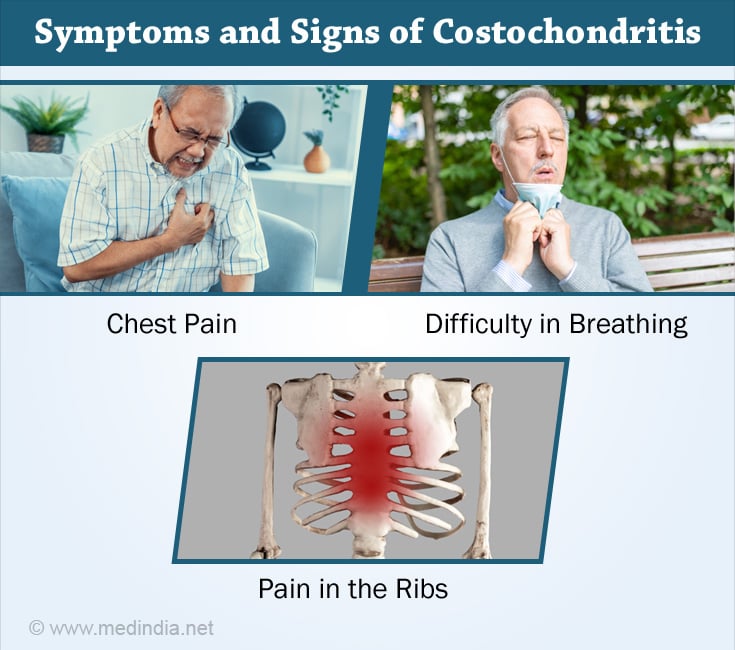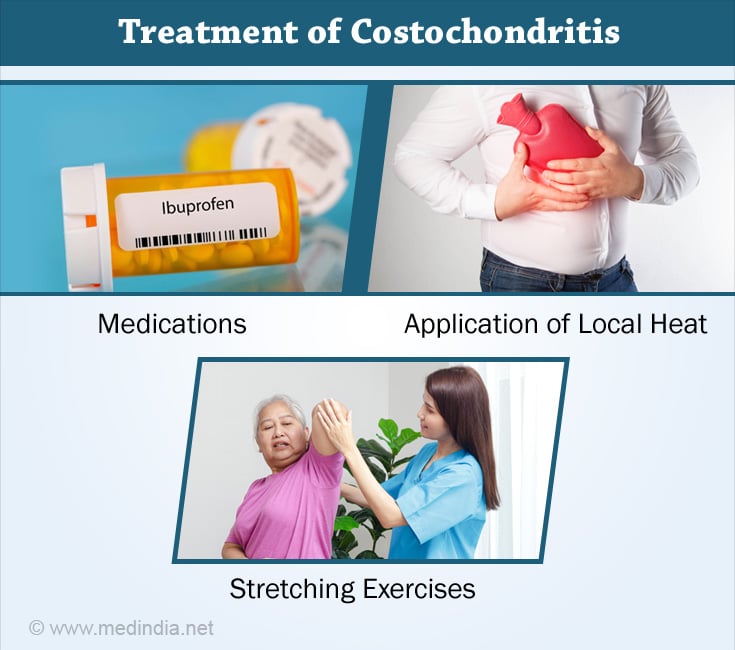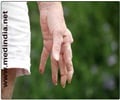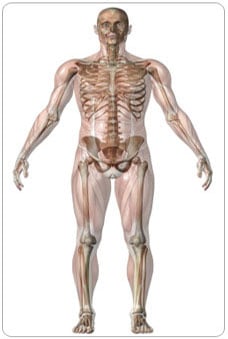- Costochondritis - (https://www.ncbi.nlm.nih.gov/books/NBK532931/)
- Severe post-COVID-19 costochondritis in children - (https://www.ncbi.nlm.nih.gov/pmc/articles/PMC8477585/)
- Tietze Syndrome - (https://www.ncbi.nlm.nih.gov/books/NBK564363/)
- Atypical Costochondritis: Complete Resolution of Symptoms After Rib Manipulation and Soft Tissue Mobilization - (https://www.ncbi.nlm.nih.gov/pmc/articles/PMC8106472/)
- Gallium Scan - (https://pubmed.ncbi.nlm.nih.gov/33620825/)
- Electrocardiogram - (https://www.ncbi.nlm.nih.gov/books/NBK549803/)
- Costochondritis - (https://www.healthdirect.gov.au/costochondritis)
- Costochondritis - (https://health.students.vcu.edu/media/student-affairs-sites/ushs/docs/COSTOCHONDRITIS.pdf)
About
Costochondritis is a medical term that describes chest pain at the junction where the ribs meets the cartilage on the chest wall. The pain can be severe and if located on the left side, it is sometimes mistaken to be pain related to heart like an angina.
The term costochondritis combines the Latin words ‘Costo’ for ribs and ‘chondro’ for cartilage. And to this when - itis is added it refers to inflammation of the cartilage.
It is often seen among people between 20 and 40 years of age. The cause is usually unknown. Females are affected more often than males.
The importance of diagnosing this entity lies in the fact that it is a benign cause of Chest pain when compared to more serious cause of chest pain like angina or heart attack (1✔ ✔Trusted Source
Costochondritis
Go to source). Sometimes the chest pain is sharp and causes much anxiety and breathing difficulty.
However costochondritis, as mentioned previously is relatively harmless condition that may go away without any treatment but due to the nature of the pain and anxiety the patient generally seeks a medical opinion.
Some children have experienced costochondritis symptom post-COVID, however its occurrence has been rare (3✔ ✔Trusted Source
Severe post-COVID-19 costochondritis in children
Go to source).
Difference between Costochondritis and Tietze's Syndrome
Sometimes Costochondritis may be accompanied by swelling of the areas surrounding the cartilage; the condition is called Tietze's syndrome.
Tietze syndrome is not a typical reason for chest pain and on examination there can be localized tenderness with swelling that has no infection. Generally it appears on 2nd or 3rd costal cartilages ribs on one side(2✔ ✔Trusted Source
Tietze Syndrome
Go to source).
Tietze’s syndrome is not Costochondritis though a large number of sources consider them to be the same as both diseases affect the same region of the chest.
Causes of Costochondritis
Costochondritis usually has no definite cause. Certain types of arthritis like
Costochondritis usually has no definite cause. Inflammation can however occur due to various reasons like:
- Repeated minor trauma to the chest wall
- Viral infections
Bacterial infections Fungal infections are rare causes for Costochondritis(1✔ ✔Trusted Source
Costochondritis
Go to source)
Symptoms and Signs of Costochondritis
The most common sites of pain due to Costochondritis are the fourth, fifth, and sixth ribs. chest pain increases on taking deep breaths or on moving the trunk. Quiet breathing brings relief in pain.
Pain is described as sharp; it may radiate to the back or abdomen
Chest pain associated with Costochondritis usually follows exercise, minor trauma, or an upper respiratory infection

The pain is reproducible by pressing the rib joints. This is characteristic.
Costochondritis that follows infection after an operation may be associated with redness, swelling, or pus discharge. Though there can be swelling in these cases it must be remembered that Costochondritis is different from Tietze’s syndrome.
Patients should visit a doctor if they develop trouble breathing, high fever, signs of infection (redness, pus, swelling at rib joints)(4✔ ✔Trusted Source
Atypical Costochondritis: Complete Resolution of Symptoms After Rib Manipulation and Soft Tissue Mobilization
Go to source).
Diagnosis of Costochondritis
Diagnosis of Costochondritis is made based on personal history and physical examination. No specific tests exist for Costochondritis.
Investigations are primarily aimed at ruling out the fatal causes of chest pain like angina or heart attack.
A chest x-ray is one of the most cost-effective investigations available to find out the cause of chest pain.- Gallium scan is a more sophisticated imaging study to check for infection. Infected areas show increased uptake of radioactive material gallium(5✔ ✔Trusted Source
Gallium Scan
Go to source). - Blood tests can also be helpful. Increase in the white blood cell count could mean infection.
- ECG is routinely ordered to rule out heart diseases(6✔ ✔Trusted Source
Electrocardiogram
Go to source).
Treatment for Costochondritis
Ibuprofen is usually the drug of choice for treatment of mild to moderate pain due to Costochondritis (if no contraindications exist)(1✔ ✔Trusted Source
Costochondritis
Go to source).
Flurbiprofen, ketoprofen and naproxen are alternatives.
Once the diagnosis is established, treatment includes:
- Adequate pain control and reassurance of the patient about the benign nature of the ailment are the prime targets in the treatment of Costochondritis. Pain control requires reduction of inflammation. Medications like Nonsteroidal anti-inflammatory drugs (NSAIDs) are useful. Flurbiprofen, ketoprofen and naproxen are alternatives for pain relief.
- Abuse of NSAIDs should never be encouraged. Patient education about the uses and adverse effects of NSAIDs is thus important.
- Application of local heat is helpful.
- Gentle stretching of the pectoralis muscles (muscles in the front of the chest) two to three times a day may help.
- Refractory cases (those that do not respond to treatment) may require local infiltration of local anesthetic, steroid, or intercostal nerve block.
- Biofeedback is another modality of management. This is a technique of manipulating certain physiological functions(7✔ ✔Trusted Source
Costochondritis
Go to source).

Prevention and Prognosis of Costochondritis
Costochondritis does not need any surgery and usually resolve on its own.
Home remedies for costochondritis:
Some of the self-care measures to be followed are(8✔ ✔Trusted Source
Costochondritis
Go to source):
- Physical exercises can be beneficial for patients with costochondritis.
- Stretching routines should be done.
- Apply heat to the costochondral area for at least 5 minutes immediately before and after stretching (using a hot water bottle, a heating pad on low heat, or a warmed, moist cloth) to increase blood flow and relax the muscles.
- After stretching, cold may also be applied to the affected area (using an ice pack covered in a towel); 10 minutes on, then 10 minutes off, for 3 repetitions if the patient finds this helpful.
- If any of these exercises increase pain, stop immediately and rest to avoid injury.
- Avoid any additional exercises that exacerbate the symptoms.
Since the exact cause responsible for Costochondritis is not known, it may not be possible to eliminate the ailment. Preventing repetitive misuse of muscles, sticking to healthy postures or better ergonomics of the home or workplaces are practices that help to reduce Costochondritis.
Prognosis
The prognosis for patients with Costochondritis is excellent. Noninfectious Costochondritis will go away on its own while infectious one takes a longer time for perfect recovery(9✔ ✔Trusted Source
Atypical Costochondritis: Complete Resolution of Symptoms After Rib Manipulation and Soft Tissue Mobilization
Go to source).















